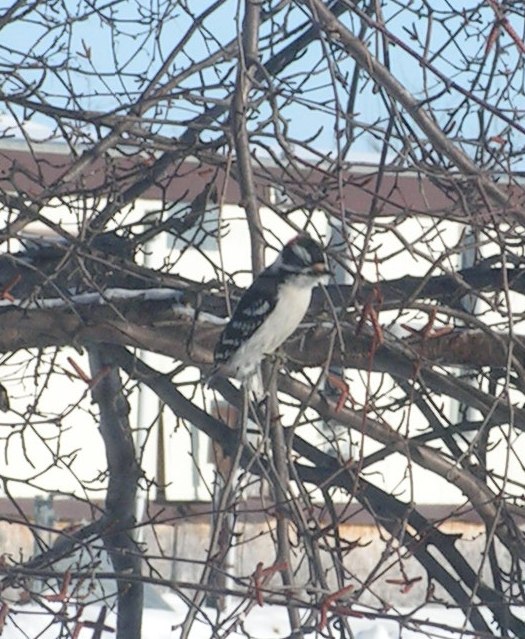 |
| Downy Woodpecker in birch tree. Margaret Madsen photo. |
The male Downy Woodpecker has set up a regular time to visit us. He's here every day between 11 and 12 and always arrives the same way. He lands first in the birch tree and carefully surveys the feeders, stretching up to get a better view. He elongates himself to about twice his height and looks so long and skinny, almost the same length as a Hairy Woodpecker. When he decides everything looks safe, he exhales back to his regular height, his body plumps out again and then he dips in for the suet.
When he was doing his inspection yesterday, the sunlight caught the red patch on the back of his head and for a moment, it glowed with jewel-like brilliance, the color of garnets. Isn't it amazing how, in the right light, certain feathers burst into dazzling flashes of color?
Even the much aligned magpie, another tough, resilient winter bird, can display breath-taking beauty. Don't we all cherish those moments when the sunlight catches the black and white bird at just the right angle and suddenly it is transformed into iridescent purple and green?
"Chickadees are cold weather machines" is the headline of an article in the spring issue of Nature Views, published by Nature Saskatchewan. Black-capped Chickadees lower their body temperatures at night to conserve energy. This nightly hypothermia is the chickadee's most remarkable tool for survival, according the American biologist Susan M. Smith who has studied them for years. In the article, she explains that this tough little bird with its dense winter coat also carefully hides food items and finds special cavities to roost in at night.
The article doesn't say anything about the chickadee's good nature. Don't you think they are the most happy-go-lucky cheerful birds in the winter landscape? Wish I was as cheerful with the forecast that this cold weather will drag on!





